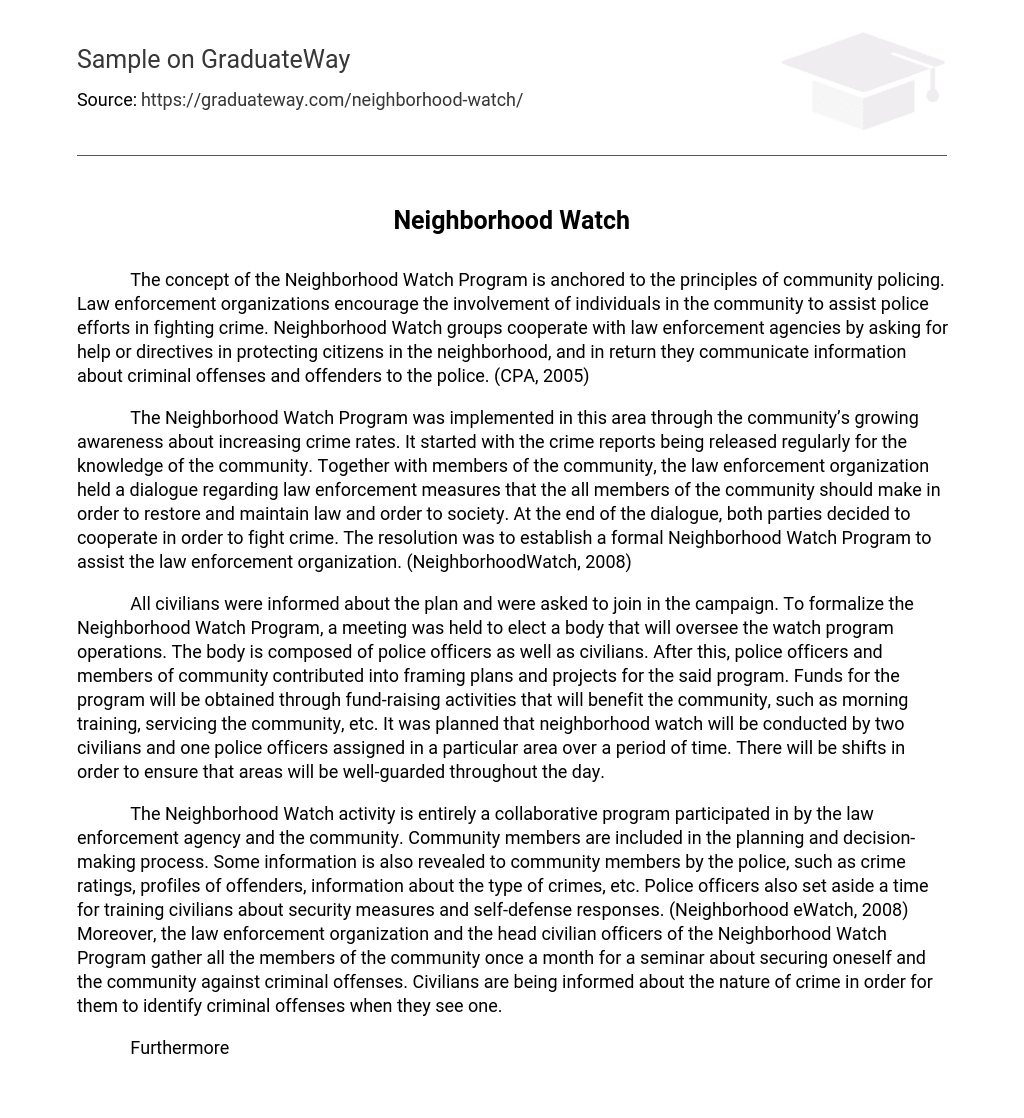The concept of the Neighborhood Watch Program is anchored to the principles of community policing. Law enforcement organizations encourage the involvement of individuals in the community to assist police efforts in fighting crime. Neighborhood Watch groups cooperate with law enforcement agencies by asking for help or directives in protecting citizens in the neighborhood, and in return they communicate information about criminal offenses and offenders to the police. (CPA, 2005)
The Neighborhood Watch Program was implemented in this area through the community’s growing awareness about increasing crime rates. It started with the crime reports being released regularly for the knowledge of the community. Together with members of the community, the law enforcement organization held a dialogue regarding law enforcement measures that the all members of the community should make in order to restore and maintain law and order to society. At the end of the dialogue, both parties decided to cooperate in order to fight crime. The resolution was to establish a formal Neighborhood Watch Program to assist the law enforcement organization. (NeighborhoodWatch, 2008)
All civilians were informed about the plan and were asked to join in the campaign. To formalize the Neighborhood Watch Program, a meeting was held to elect a body that will oversee the watch program operations. The body is composed of police officers as well as civilians. After this, police officers and members of community contributed into framing plans and projects for the said program. Funds for the program will be obtained through fund-raising activities that will benefit the community, such as morning training, servicing the community, etc. It was planned that neighborhood watch will be conducted by two civilians and one police officers assigned in a particular area over a period of time. There will be shifts in order to ensure that areas will be well-guarded throughout the day.
The Neighborhood Watch activity is entirely a collaborative program participated in by the law enforcement agency and the community. Community members are included in the planning and decision-making process. Some information is also revealed to community members by the police, such as crime ratings, profiles of offenders, information about the type of crimes, etc. Police officers also set aside a time for training civilians about security measures and self-defense responses. (Neighborhood eWatch, 2008) Moreover, the law enforcement organization and the head civilian officers of the Neighborhood Watch Program gather all the members of the community once a month for a seminar about securing oneself and the community against criminal offenses. Civilians are being informed about the nature of crime in order for them to identify criminal offenses when they see one.
Furthermore, part of the program is to empower all the members of the community to take part in fighting crime by reporting to the police. It is a known fact that law enforcement organizations cannot carry out their duties and responsibilities efficiently if victims and witnesses do not report the crimes they experience. Therefore, the importance of reporting crimes to the police is reiterated to civilians for them to be able to participate in keeping law and order to society.
Other features of the program include training in communications with the use of technological gadgets, such as high frequency radios, etc. Civilians who will participate in the neighborhood watch will also be trained to handle lighter self-defense gadgets for their own protection. Aside from this, drills will be conducting in order to prepare civilians for specific situations that require speedy action, such as witnessing arson, shooting, etc. Civilians will be taught how to respond quickly without allowing themselves to get hurt, and lessen the damage that a particular crime will produce.
Performance assessments will be done on a regular basis in order to ensure that the program is running to meet its goals and objectives, and the people who are involved are doing their duties and responsibilities. Program evaluation will also be instrumental in the further improvement of the Neighborhood Watch Program. As far as the law enforcement organization is concerned, the implementation of the Neighborhood Watch Program has decreased crime rate in the area, owing to the role that community members are contributing to keeping the peace and order in the community. As of now, the organization is looking into other possibilities of expanding the program in order to ensure that crime is eliminated.
References
CPA. (2005). “Neighborhood Watch.” Retrieved August 28, 2008, from Crime Prevention
Association of Michigan. Website: http://www.preventcrime.net/NeighborhoodWatch.htm
Neighborhood eWatch. (2008). “Neighborhood Watch.” Retrieved August 28, 2008, from The
City of San Diego. Website: http://www.sandiego.gov/police/prevention/neighwatch.shtml
Neighborhood Watch. (2008). “More About Neighborhood Watch.” Retrieved August 28, 2008,
from Neighborhood Watch.org. Website: http://toneighborhoodwatch.org/more_nw.htm





